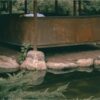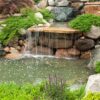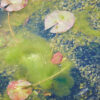What type of filtration system should I use for a 250L pond? For a 250L pond, there are different types of systems on the market that I had the opportunity to test. There are complete filters that integrate the pump, the filter and the UV, such as the FILTRAL range from OASE. There are also pressure filters or pumping filters.
The first question to ask yourself before installing a filtration system is whether you will be putting plants and fish in your pond. It is also helpful to look at the sun exposure of the pond and the trees that surround it. Not sure which system to choose for your garden? Contact us.
- Filters in complete kit => FILTRAL
- Pressure filters => BIOPRESS / TOPCLEAR / PONDOPRESS
- Pumping filter => BIOSMART
I recently discovered a website that presents different filtration systems adapted to your garden pond. Here is the list of filtration systems for ponds of 250L minimum.
Why should I filter a small pond?
For a 250L pond, an air pump is the first thing to install. A 250L water volume is sensitive to temperature (faster and more important variation). The use of a small filtration system and an oxygenation solution is preferable to ensure the well-being of the living creatures in the garden pond.
This will provide nutrients for the aquatic plants, which in turn will release oxygen into the water for a healthy pond environment.
Even when the pond has been well designed, problems can occur that upset the biological balance. This can lead to unwanted algae growth.
How to avoid algae?
We have some tips to counteract algae formation.
- Place more pond plants
- Use bacteria that will digest nutrients
- Avoid bottom waste and clean the filter.
- Your fish should eat everything quickly.
- Remove as much algae as possible by hand
- Monitor your water quality
- Use an algae treatment
Algae control
The first step to having an algae free pond is to test the water and based on the results, a diagnosis and a plan to remove the algae can be made. For the pond environment a knowledge of the pH-value is essential because it tells us what the CO2 content of the water is. If in the morning the pH value is relatively low (pH 7-8) and in the evening it is relatively high (pH 8-9), then the pond environment is working, the plants will grow well and the water will be clear.
The use of peat aggregate can accelerate the decrease of the pH-value. If the pH-value is too low (pH 6 and below), the pond environment becomes acidic and threatens all inhabitants of the pond. Especially during the winter, low pH values can occur under certain conditions. The general hardness of the water is determined by calcium and magnesium. This becomes the GH value of the water. A good GH value for pond water is between 8° and 12° dH. Most pond plants grow optimally in these values and the development and activity of microorganisms is optimal in this medium hard water.
Carbonate hardness (KH value) is an important pillar in the pond environment. The KH value is also called temporary hardness. It is also referred to as the antacid strength.
Excess nutrients in the water can have several causes:
- high a phosphate content
- too much food for the fish
- too many fish
- not enough plants
- inadequate filtration
- poor bacteriological water balance
- insufficient water quality
_______________________________________________________________________
Aquigarden is reader-supported by Adsense & Amazon LLC. When you buy throug links on our tips site, we may earn an affiliate commission. Learn more. Aquigarden is a participant in the Amazon Services LLC Associates Program, an affiliate advertising program designed to provide a means of sites to earn lead fees by linking to Amazon.com
We only give our own opinion. We only give our own opinion. We do not accept any liability. We recommend that you always call in a professional in pond & pool.











Pingback: How To Keep Pond Water Clean For Fish - Aquigarden.com